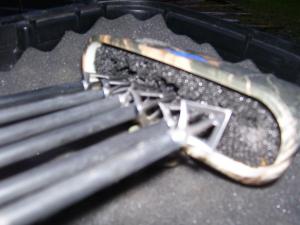Broadhead Basics
Broadhead Basics
A bow hunter needs to be well versed in different types of equipment and techniques to be an effective hunter. They should also be aware of the limitations of their equipment. One of the most important pieces of equipment a bow hunter is a Broadhead. In fact everything a bow hunter has and does, all comes down to the front of their arrow.
The animal deserves respect and has to be hunted in a humane way and not be wounded. A quick humane kill hunt requires proper choice of broad heads and Kinetic energy. A broad head is the cutting and penetrating device attached to the front of the arrow shaft.
Choosing the right broad head
Hunting factors like the velocity required, the penetration, the distance the arrow has to travel and most importantly the skill level of the bow hunter determine the type and make of the broad head to be used. A good broad head has to cut efficiently, reduce flight deviation, and should be stable on impact. Based on their physical properties, broad heads fall in two categories: fixed blade and mechanical blade.
Personal preferences based on past experience influences the choice of broad head for most hunters.

A quiver full of my personal favorite, G5 Montecs.
Using a bow with a longer draw length, or heavier draw weight results in increased speed, velocity, and more kinetic energy, offering more options in choosing the right broad head. High kinetic energy, momentum, and velocity result in deeper penetration as well as produce a large blood trail when using the proper broad head. While hunting small game, where penetration is not the issue judo points, field tips, or small game heads work well.
Fixed blade and Mechanical blade are the two configurations that are available. There are two types of fixed blades: Replaceable and One Piece
Replaceable types of broad head are most popular with beginners. When the blade looses its edge, the blade is just replaced to avoid the cumbersome process of sharpening. Two, three, and four blade configurations are available. However, for beginners fewer blade configurations are advisable. More number of blades increases the wind resistance causing a dive. Upward planning of the arrow calls for tuning the bow and broad heads. To avoid doing this use smaller broad heads. This does not eliminate tuning, but surely reduces it.
My personal favorite: One piece has a sharper tip that goes through the hide first. The blade then does the cutting. Loss of energy is reduced and penetration increased. Cut on contact broad heads are another name for this style. They are also the strongest and toughest style of head.
Mechanical broad heads: Arrows with this type of broad head fly straighter as there is no drag due to the blades. The razor sharp, extendable blades open up after entering the hide cutting the muscle and arteries. The thicker the material of the extendable blade, the more stress it can take on impact. The bow also should have a draw weight in excess of 55 pounds.
Weight and Size
Weight of a broad head is also an important factor. They range from 85 grain heads to 140+grain heads. For lighter shafts like fiberglass, carbon and lightweight aluminum, 100-grain heads are recommended, whereas for heavier aluminum shafts 125-grain are recommended. Traditional bow hunters use heavy 2 blade broad heads.
Depending on the weight, and the number of blades of the broad head the bow has to be tuned. Cutting diameter size should be 1 1/16th +.
Inspecting your broad head and arrows
Check the straightness of the arrow shaft.
Check the alignment of the broad head by spin-testing the shaft and the head should not wobble. You must tune your broadheads before using them.
Check the quality of the make and the machining of each broad head.
Weigh each broad head on a calibrated scale and check for inconsistency in weight.
Check the length of each broad head from the tip of the point to the tip of the threaded section.
If you want you could perform the penetration test by launching the arrows from a distance of 15 feet into a sheet of plywood about ¾” thick. Measure the distance from the backside of the plywood to the tip of the broad head.
Check the tested arrow broad head blades for any visible damage by comparing them to new broad heads of the same brand.
Muzzy, Montec, NAP are some amongst other manufacturers of different type of broad heads in North America.
Don’t be content with the broad heads you have been using all this while. Every year manufacturers introduce new models with increased cutting efficiency, reduced flight deviation, and greater stability. It is worth giving it a try. Check out this interesting story of a trophy archery white tail deer hunt in Alberta.


